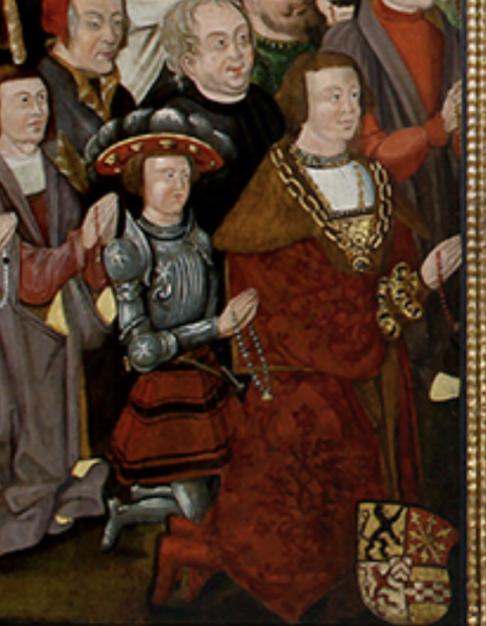John III, Duke Of Cleves on:
[Wikipedia]
[Google]
[Amazon]
John III, Duke of Cleves and Count of Mark ( German: ''Johann III der Friedfertige''; 10 November 1490 – 6 February 1539), known as John the Peaceful, was the Lord of Ravensberg, Count of Mark, and founder of the United Duchies of Jülich-Cleves-Berg.

Life
John was born on 10 November 1490, as the son of John II, Duke of Cleves, and Mathilde of Hesse. In 1510, at the age of 19, John married Duchess Maria of Jülich-Berg, daughter of Duke William IV of Jülich-Berg and Sibylle of Brandenburg, who became heiress to her father's estates Jülich, Berg and Ravensberg. John became ruler of the United Duchies of Jülich-Cleves-Berg in 1521, and Lord of Ravensberg in 1528. John represented a compensatory attitude, which strove for a ' between the two confessions during theProtestant Reformation
The Reformation, also known as the Protestant Reformation or the European Reformation, was a time of major theological movement in Western Christianity in 16th-century Europe that posed a religious and political challenge to the papacy and ...
. In fact, the real influence at the court of Cleves was Erasmus
Desiderius Erasmus Roterodamus ( ; ; 28 October c. 1466 – 12 July 1536), commonly known in English as Erasmus of Rotterdam or simply Erasmus, was a Dutch Christian humanist, Catholic priest and Catholic theology, theologian, educationalist ...
. Many of his men were friends and followers of the Dutch scholar and theologian. In 1532 John wrote up a list of church regulations (''Kirchenordnung''), which expressed numerous ideas of Erasmus.
John had an instinct for balance as was shown when he married his eldest daughter Sybille to the elector of Saxony, John Frederick. John Frederick would go on to later head the Schmalkaldic League
The Schmalkaldic League (; ; or ) was a military alliance of Lutheranism, Lutheran Prince of the Holy Roman Empire, principalities and cities within the Holy Roman Empire during the mid-16th century. It received its name from the town of Schm ...
. In many ways, John of Cleves' court was ideal for raising a queen. It was fundamentally liberal, but serious-minded, theologically inclined, and profoundly Erasmian. It was from this court that his daughter Anne
Anne, alternatively spelled Ann, is a form of the Latin female name Anna (name), Anna. This in turn is a representation of the Hebrew Hannah (given name), Hannah, which means 'favour' or 'grace'. Related names include Annie (given name), Annie a ...
would be raised. Anne became the fourth wife of King Henry VIII
Henry VIII (28 June 149128 January 1547) was King of England from 22 April 1509 until his death in 1547. Henry is known for his Wives of Henry VIII, six marriages and his efforts to have his first marriage (to Catherine of Aragon) annulled. ...
of England.
Family
John and his wife Duchess Maria of Jülich-Berg had the following children: # Sibylle of Cleves (17 January 1512 – 21 February 1554); married Elector John Frederick of Saxony, head of the Protestant Confederation of Germany, "Champion of theReformation
The Reformation, also known as the Protestant Reformation or the European Reformation, was a time of major Theology, theological movement in Western Christianity in 16th-century Europe that posed a religious and political challenge to the p ...
". Had issue.
# Anne
Anne, alternatively spelled Ann, is a form of the Latin female name Anna (name), Anna. This in turn is a representation of the Hebrew Hannah (given name), Hannah, which means 'favour' or 'grace'. Related names include Annie (given name), Annie a ...
(22 September 1515 – 16 July 1557); who was briefly married to King Henry VIII
Henry VIII (28 June 149128 January 1547) was King of England from 22 April 1509 until his death in 1547. Henry is known for his Wives of Henry VIII, six marriages and his efforts to have his first marriage (to Catherine of Aragon) annulled. ...
of England, as his fourth wife. No issue. The marriage was annulled on 12 July 1540, on the grounds of non-consummation and her pre-contract to Francis of Lorraine.
# William
William is a masculine given name of Germanic languages, Germanic origin. It became popular in England after the Norman Conquest, Norman conquest in 1066,All Things William"Meaning & Origin of the Name"/ref> and remained so throughout the Middle ...
(28 July 1516 – 5 January 1592); married Archduchess Maria, daughter of Emperor Ferdinand I, and had issue.
# Amalia (17 October 1517 – 1 March 1586); became Princess of the House of La Marck
The House of La Marck () was an ancient German nobility, German noble family, which from about 1200 appeared as the Counts of Mark.
History
The family history started with Count Adolf I, Count of the Mark, Adolf I, scion of a cadet branch of th ...
.
John also had with an unknown woman;
Elisabeth of Cleves (b.?- 15 July 1554) Married Gottfried von Bemmel, bailiff of Kervendonk and had issue.
Daughter (?- ? ) Became a nun.
Ancestry
References
Sources
* * * * * * * {{DEFAULTSORT:John 03, Duke of Cleves 1490 births 1539 deaths Dukes of Cleves House of La Marck Dukes of Berg Counts of the Mark